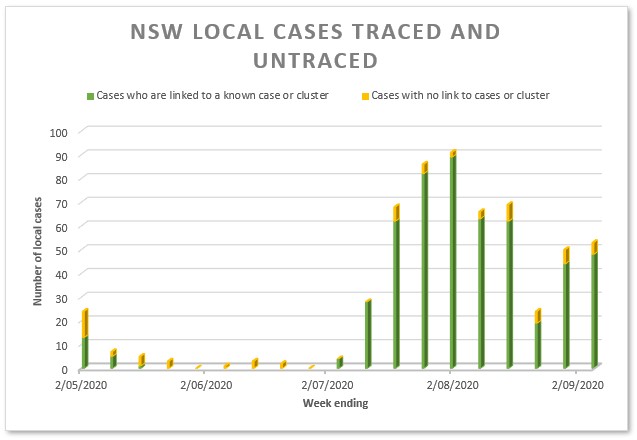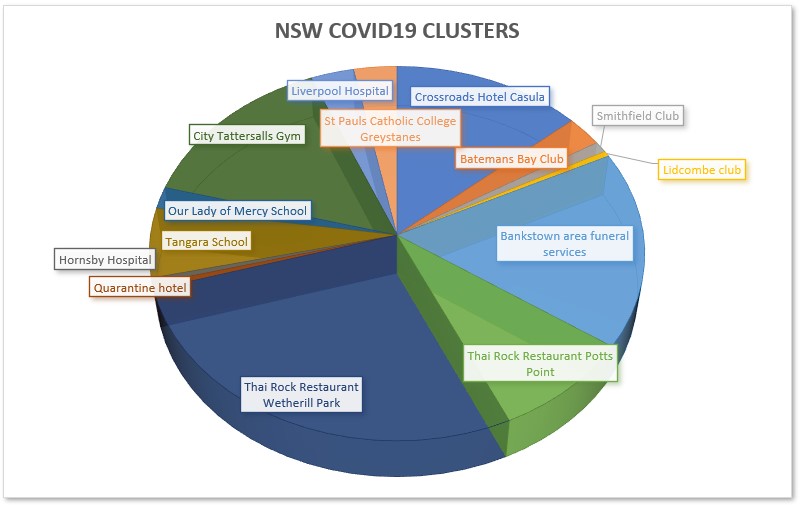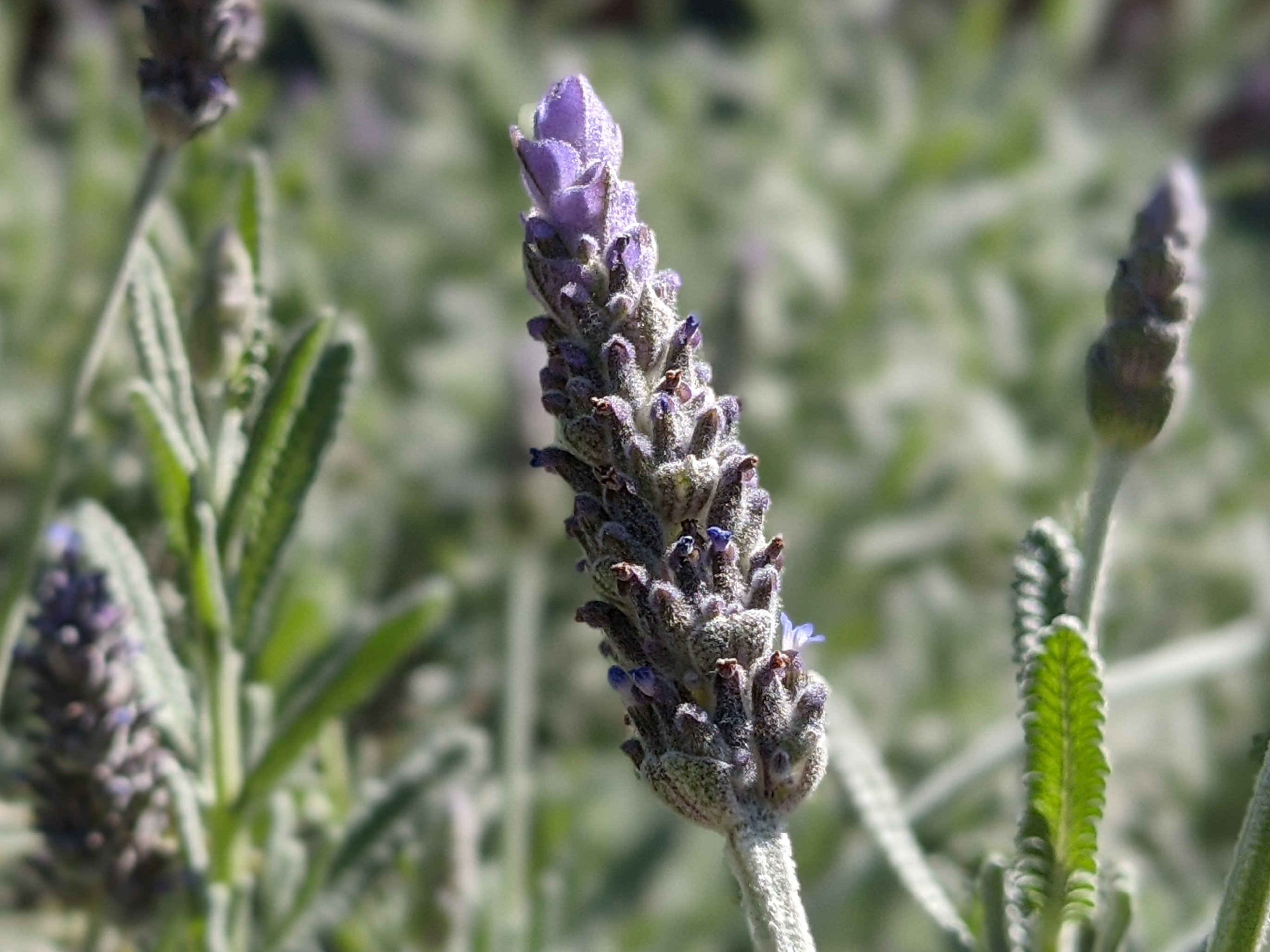In NSW, after the home, the most likely place for transmission of Covid19 is a café or restaurant.
NSW publishes a weekly report on the Covid19 pandemic – you can read them all here. Since 1 July they have been reporting on their analysis of each of the clusters in NSW, and where transmission has occurred.

Their analysis shows an average of around 4 cases a week since 1 July have had no traceable links to clusters (in some cases these are also the index case in a cluster). That number has been reasonably stable in that period, although it is interesting to read the weekly reports – the unlinked cases were often higher in the week the cases occurred, and then further analysis and detective work identified the links.
The individual clusters analysed (adding up to a total of 419 cases between 1 July and 5 September) are shown in the chart below, with the biggest individual cluster being the Thai Rock Restaurant, Wetherill Park (114 cases).

The insight I was looking for is where transmission actually occurred. The reports show the results of the contact tracing, and so show the location where transmission of the virus occurred. A cluster (such as the Thai Rock Restaurant cluster) can start in one place, a restaurant, but transmission then occurs via a chain of steps in a number of locations. That particular cluster includes school, church, workplace and household transmission, as well as the restaurant that started it all.

Transmission occurs most often in households – not surprising, as that is the place where we relax the most (the category of “other home” is mostly somebody else’s home, but is sometimes used when people have contacts in a variety of places, but don’t live together). The next most frequent location for transmission is a café or restaurant. That is a location of transmission not just for the various clusters that started there, but also in a number of other clusters that started elsewhere (for example one of the schools).
What I would really love to know is what proportion of the contacts identified by NSW Health go on to convert into transmission events. There is probably a great research paper in it from someone in NSW Health if they weren’t too busy finding new contacts. That way we could understand whether cafés and restaurants really are the riskiest location (besides the obvious household location) or whether it was just that these particular clusters included a lot of people who already spend time in cafés and restaurants. This research study from the US suggests that it is actually that the café/restaurant/club is more risky, not just random chance:
Findings from a case-control investigation of symptomatic outpatients from 11 U.S. health care facilities found that close contact with persons with known COVID-19 or going to locations that offer on-site eating and drinking options were associated with COVID-19 positivity. Adults with positive SARS-CoV-2 test results were approximately twice as likely to have reported dining at a restaurant than were those with negative SARS-CoV-2 test results.
Disclaimer: NSW Health has been tweaking the way they report transmission and clusters every week or so during this period. While each tweak makes the report more useful going forward, it has made it challenging to stitch the numbers together. I suspect someone else doing this analysis would have a slightly different set of numbers, but the broad outcome would be the same.
The power of the collective
As I watch people I know try to decide how much of the many and varied guidance there is about Covid19 restrictions, I notice that most people express their decision making in terms of their own personal risk. Should they go to a restaurant? They decide whether to do so based on their view of how likely they are to catch Covid19 by doing so.
But the question for our public health officials is not the same. What they are trying to do is reduce the risk of community transmission. So a risk that I might be prepared to take such as going to a crowded pub (because there is still not very much virus in the community) is OK for me personally, but if every person in NSW does the same thing, the risk of community transmission would skyrocket, because the one random person who is infectious will suddenly make it worse for the whole community. And some individuals are at greater risk from Covid19 than others – but all of our actions will increase the risk for those people.
Philosophically, it is a little bit like voting – I know that my own individual vote will make no difference to an election, but I still vote, because of if none of us vote, an election doesn’t happen. In the Covid19 case, each individual action is unlikely to make a big difference to an outbreak, but the combination of all of our actions substantially changes the risk for the community, both now and into the future.
So how does the government manage this tension between individual choices, and collective action?
In Australia, some of the political tension has been between those, like Victoria (but also Tasmania, early on) who have imposed rules around the behaviour that will reduce the likelihood of infection, and those, like NSW, who have tended to provide guidance and asked people to make their own decision.
But many people don’t want to have to make a risk based decision about every thing they do, they would prefer someone else made the decision for them. I really noticed this when having the weekly discussion with my choir – there aren’t clear rules (outside weddings and funerals) about singing in NSW. So each choir is trying to work out whether there are situations where the risk is low enough to sing together. We would probably rather someone came up with some standard rules.
Another example that gets a lot of conversations is masks – the majority of Australians support mandatory face masks. Interestingly, though, quite a lot of those people who support mandatory mask wearing are not currently wearing masks when they are out in public.
On balance, I’m in favour of a little bit less guidance, and a few more rules – in particular, if a government is strongly recommending a course of action (such as wearing masks on public transport) I think it would be simpler if they made it mandatory. That doesn’t mean I support punitive fines, or draconian police arrests of those breaking the rules. We are a fairly law abiding society, and the strong (my prediction would be 90%+) compliance we would get with a rule as opposed to guidance would probably be enough.
I would not have expected to be in this position if you’d ask me before this all started.
This is my 50th Covid19 reflections post, so I’ve gone a little bit philosophical this week to mark the occasion.
Links
This study looks at whether people wearing masks have an added benefit to the already well known benefit of reducing spread of disease – those who are infected with Covid19 while wearing a mask may end up with a less severe disease. The authors speculate that this could ultimately be similar to variolation (the method first used to immunize an individual against smallpox (Variola) with material taken from a patient or a recently variolated individual, in the hope that a mild, but protective, infection would result. The procedure was most commonly carried out by inserting/rubbing powdered smallpox scabs or fluid from pustules into superficial scratches made in the skin. The patient would develop pustules identical to those caused by naturally occurring smallpox, usually producing a less severe disease than naturally acquired smallpox.)
Recent virologic, epidemiologic, and ecologic data have led to the hypothesis that facial masking may also reduce the severity of disease among people who do become infected.3 This possibility is consistent with a long-standing theory of viral pathogenesis, which holds that the severity of disease is proportionate to the viral inoculum received.
Ultimately, combating the pandemic will involve driving down both transmission rates and severity of disease. Increasing evidence suggests that population-wide facial masking might benefit both components of the response.
Another good reason for mask wearing to be made compulsory indoors.
Life Glimpses
As I rode my bike through the (quite deserted) streets of Sydney’s CBD this week, I saw two people that my subconscious told me were lost tourists – they were huddled over a mobile phone on a street corner. But then my conscious mind kicked in and I realised that there are probably no tourists in Sydney these days. The only people who might be tourists would be from other parts of NSW, and I don’t imagine many of them would be coming to Sydney from country areas with no Covid19, especially outside of school holidays.
I was quite taken aback – I’ve always enjoyed living in a city that people would come to as tourists, and seeing others enjoy the natural beauty we live in, but now our city is for locals only.
Bit of beauty
Today’s bit of beauty comes from geekinsydney, from our daily walk. As we move into spring, I’m noticing the wide variety of flowers on our local streets more than I ever have before.


Thanks, Jennifer,
Interesting to consider science v instinct v statistics. Cafes and restaurants do seem to pose risks – indoors; for some time; probably closer than 1.5m to converse; minimal ventilation – but hard to verify with facts.
I must confess that on Saturday afternoon I felt comfortable watching a rugby match live – outdoors; standing up; small group (not wearing masks because they were drinking beer); mixing conversation partners – so now I wonder what an objective risk assessment would reveal?
I think as we move into warmer weather here in the southern hemisphere as much as possible of our social lives should move outside. So even though I wouldn’t have been at your rugby match, that’s more because I’m not into rugby than any other reason! I might do a search for my next post for statistics – I’ve read a few places that say that outdoors is 10-20 times less risky than indoors, but I’ve not looked for a source yet.
I am in America. Believe me, your statistics and work is greatly appreciated. Though the data is not specifically related to our country, the data points to specific American failures.
I am Horrified by my country’s lack of comprehension. Masks and social distance have been practiced in Asia for decades. I used to think it strange. But, if a person were to read about population size, and then read about flu epidemiology hopefully a correlation between the two would reach them.
Please remember, your reach is global. I wasn’t looking for your site, but am grateful.
Your presentation in each article is concise, observable, and fact based. I also appreciate your views on other actuarial science. thank you
Today I read the serious part as well . I do agree that people need rules. The majority will follow and some will disobey just to be difficult. Do thank geekinsydney for the lovely photo, We are going to have a lockdown for 3 weeks as from 18.9. Many discussions, some people are annoyed that the number of people in the synagogues has to be limited. I think one can pray anywhere, this is a secular person voicing an opinion. I go out in a mask and try to keep my distance.
Love Marta